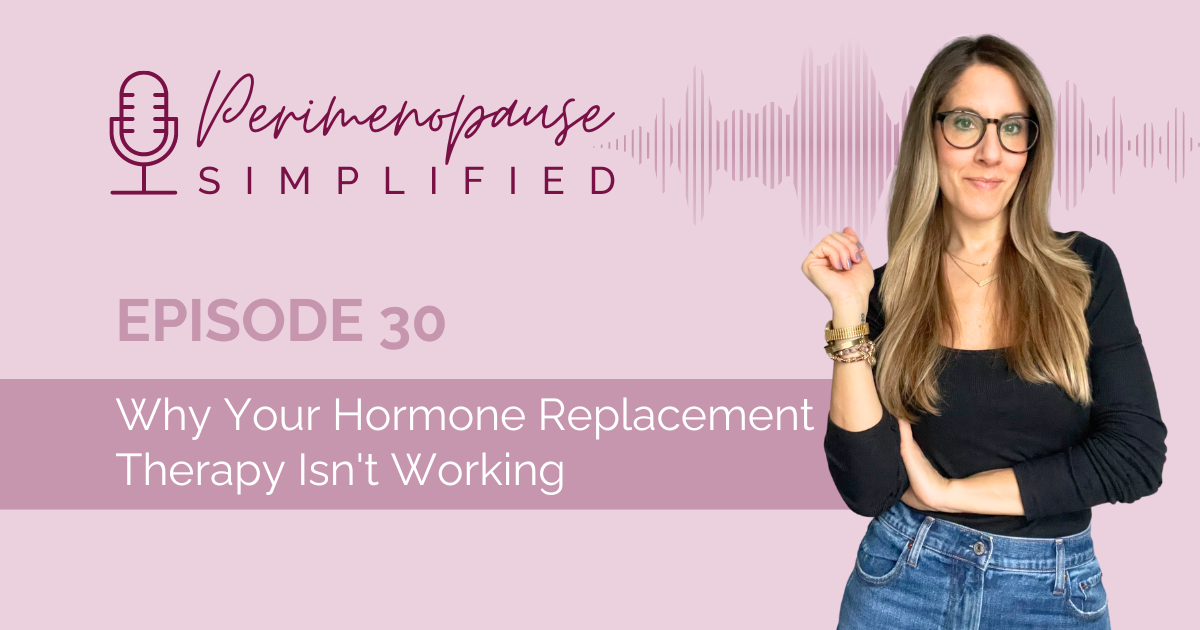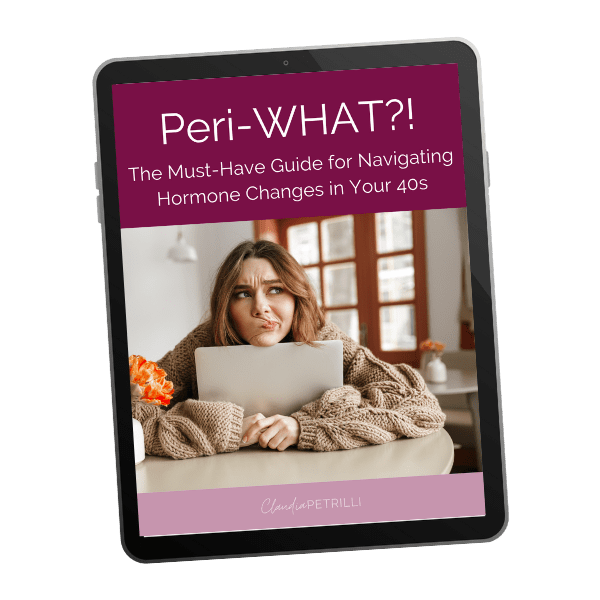
30. Why Your Hormone Replacement Therapy Isn’t Working
Don’t Miss An Episode!
In this episode, we covered:
- Why I recommend bioidentical hormones
- Progesterone resistance
- Is your dose too high or too low?
- Is your provider ignoring your need for estrogen?
- Why we need to be open to different forms of HRT
- What I believe is most important for HRT to be effective
Common HRT Challenges
I hear from a lot of women who start hormone replacement therapy that they don’t feel right, they often feel worse, and they get frustrated because their provider doesn’t give them much support. And unfortunately, they get discouraged and even stop taking hormones.
This is upsetting to me as I’ve found so much benefit from being on HRT, I’ve seen great outcomes with clients, and I know it can be incredibly health supportive for so many women, of course, in addition to vital food & lifestyle changes in perimenopause and beyond.
If you’re new here, I’ve talked about hormone replacement therapy in previous episodes, so go back and listen to those, as I’m not going to dig into the safety, history, or efficacy in this episode.
So say you started HRT but you feel like it’s not working…or you feel worse. Here are some things to consider…
Your doctor put you on synthetic hormones versus ‘bioidentical’.
For example, you may be on a progestin vs. progesterone. Now there are plenty of doctors and well-known hormone experts, who do recommend progestins and use them personally. And some may even use the terms interchangeably. But they are different. I recommend women use bioidentical hormones when possible. They mimic the exact molecular structure as the hormones your body produces naturally. The argument for the use of progestins is that some women are progesterone resistant which I’ll get into in a minute, some women have very heavy bleeding so a progestin will reduce that fairly quickly, and also to protect the uterine lining if you’re on estrogen HRT. But progesterone can also help with heavy bleeding, protect the uterine lining, and has many more benefits like improving sleep, mood, weight and more.
Understanding Progesterone Resistance
In regards to progesterone resistance, I want to touch on this because even though it’s rare, we are seeing this more and more with women. It’s certainly a case-by-case basis. But some reasons are: you may be sensitive to excipients if you’re using a commercial progesterone (yes, this is still bioidentical but there are some ingredients like peanut oil you may be sensitive to). Another reason is your gut and immune system may be in overdrive and need support. There’s also a possible association with PMDD (Premenstrual dysphoric disorder). It seems women with PMDD may have trouble with a prominent metabolite of progesterone, allopregnanolone. It can cause depression and anxiety. So some providers recommend starting low and slow with dosing. But commercial progesterone starts at 100 mg so this is where compounded can be a great option, as you can start at a very low dose. Or some women need to insert progesterone vaginally or rectally, or even use a topical formulation, versus taking it orally.
Considering HRT Pellets
Another reason your HRT may not be working is: you have pellets. Now no judgment if you use pellets or you’re a provider who uses them with patients. I’ve said this before, I don’t like the black-and-white thinking when it comes to the various HRT options. We’re all unique and have different needs. Some women love pellets, but others feel terrible because the dose cannot be titrated once they’re inserted. And a lot of doctors who recommend pellets don’t have a ton of training in hormones.
Starting Dose: Too High or Too Low?
Another reason is your doctor started your dose too high. Ideally, you’d start low and slow, increasing until you find your sweet spot. This is true for progesterone, estradiol, and testosterone.
Conversely, your dose may be too low. Many doctors think women should be on the lowest dose possible. This is just FALSE. Some women need high doses (i.e., 400 mg of progesterone) or the highest dose estradiol patch (like I currently have) to feel their best.
The Importance of Estrogen in HRT
Another thing to consider is you’re only on DHEA, testosterone, and/or progesterone. But your provider isn’t addressing your need for estrogen. This drives me bananas because too many providers tell women they don’t need estrogen if they’re still cycling or have a regular period. But if you have symptoms of low estrogen like joint pain, vaginal dryness, dry eyes/skin, frequent UTIs, urinary incontinence, low libido, low mood to name a few, then you very likely need some estrogen.
Exploring Different Hormone Delivery Methods
You may need a different type (for example, you may not love an estradiol patch or have issues with absorption, where maybe a cream is better or even oral estrogen. And yes, lots of people are against oral estrogen, but again, it’s a case-by-case basis. Another example is maybe you had testosterone pellets inserted or you did injections and didn’t do well with those, so maybe a compounded testosterone cream may be a better option for you.
The Role of Lifestyle and Dietary Changes
Lastly and most importantly, in my professional opinion, you haven’t made any dietary or lifestyle changes OR addressed underlying imbalances like nutrient deficiencies, poor gut health which I mentioned earlier, stress, and detoxification. Hormones are incredible, clearly, I’m an advocate for them, but they aren’t a silver bullet. So if you’re eating a lot of processed foods, sugar, drinking alcohol, have poor sleep hygiene, meaning you get to bed late, are on your phone etc., then please please please grab my free guide that gives you some practical action steps to take NOW to start supporting your body through these hormone changes in perimenopause.
Sources:
https://www.ncbi.nlm.nih.gov/pmc/articles/PMC6497082
https://www.ncbi.nlm.nih.gov/pmc/articles/PMC7231988/
Claudia Petrilli is a Functional Health Coach, Integrative Nutrition Coach, Women’s Health Educator, and creator of The Hormone Rescue program. Having experienced debilitating periods, digestive issues, a sluggish thyroid, a pituitary tumor, and perimenopause symptoms in her late 30s, she knows exactly what it’s like to get dismissed by doctors and spend years searching for answers.
To connect with Claudia Petrilli:
FREE GIFT: Peri-What?! The Must-Have Guide for Navigating Hormone Changes in Your 40s
WORK WITH US: The Hormone Rescue Program
QUESTIONS? EMAIL: claudia@claudiapetrilli.com
LOVE THE SHOW?! Please subscribe, leave a 5-star rating, review, and share, so that other women can find this podcast for guidance and support through their perimenopause journey!






